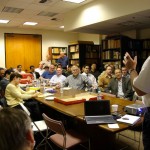Background and Final Report
With funding from the California Office of Emergency Services, the Concrete Coalition has built a network of volunteer engineers in California who have gathered information on the number and types of pre-1980 concrete buildings that exist in the 23 counties with the highest seismicity in the state. This has helped to understand the risk represented by these buildings.
For purposes of this project, the Coalition uses “pre-1980 concrete buildings” as a practical surrogate for “non-ductile concrete buildings.” The Coalition has now estimated the number of pre-1980 concrete buildings in the 23 counties (and two additional cities) with the highest seismicity and exposure, using sidewalk surveys, public records, data compiled by government agencies, and a regression model. Coalition members recognize that there is a large uncertainty with some of these numbers, particularly those generated by the regression model, and encourage volunteers throughout the state to conduct surveys in the cities with questionable data. Over time it is expected that these estimates will improve and as more city surveys are provided, the robustness of the regression model will improve.
Table 1 summarizes the estimate as of this writing.
Table 1
Estimated Number of Pre-1980 Concrete Buildings in the 23 Highest Seismicity and Exposure Counties of California
| Private buildings | 14,000–15,000 |
| K-12 public schools and local government buildings | 1670-1770 |
| State government buildings including UC and CSU buildings | 540–710 |
| Federal government buildings | 9 |
| TOTAL ESTIMATE | 16,000–17,000 |
Not all of these buildings are collapse hazards or even prone to severe earthquake damage. The next level of inventory and loss estimation involves more careful study of specific buildings, applying our understanding of the riskiest structural conditions and details.
Guidance provided to volunteers
Guidance was provided to the volunteers, through several training sessions, walk-around days and written materials. The written materials are available below:
Volunteer Guidance Manual (pdf)
What to Count (pdf)
 Report
Report